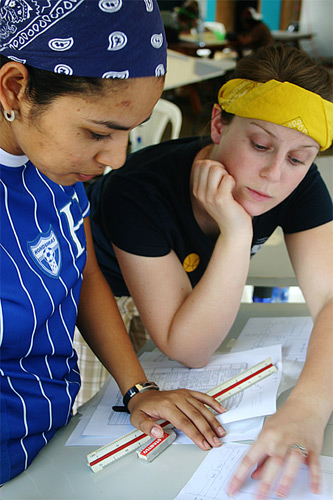
It’s among the poorest parts of the capital city in the second-poorest country in the Western Hemisphere. Helping to nurture community spirit and hope amid that poverty is the aim of Guelph students designing and building a park this month in the Nicaraguan capital.
Eleven U of G students in landscape architecture and international development are in the Grenada barrio in the capital city of Managua. Staying in local homes and a community house and working with Nicaraguan students and organizations, they will learn how to turn their Guelph studies into community development for a poor country, says Prof. Larry Harder, Environmental Design and Rural Development.
He’s a principal in the project along with architects, artists, designers and community representatives from Nicaragua and El Salvador.
Guelph and Nicaraguan students will design and build a park on municipal property near several institutions, including a church, an elementary school, a community hall and sports facilities. Intended for passive and active recreation, Harder says the property is meant to provide a “sense of place” to foster community ownership, pride and involvement.
He says Nicaragua faces numerous challenges and has hundreds of non-governmental organizations working on development projects. So why focus on building a park in a poor Managua barrio?
“Community-building and community capacity development are important. Community is about social networks, public open space and a clean, safe environment as much as it is about sewage systems and economics,” he says. He adds that many public spaces in the capital are taken over by squatters or uncontrolled development. “My objective is not to change the world. It’s a question of ripples.”
He also wanted to give Guelph students a look at a community development project in Latin America.
About 2,600 people live in the Grenada barrio; almost half of the 500 households are headed by women, and about one-third of the population is less than 15 years old.
This month’s trip grew out of his visit last year to the country. The visit was organized by Gonzalo Duarte, a Canadian who lives in Nicaragua and runs Companeros Inc., which organizes volunteer and service learning trips. Other partners are Habitar, a Nicaraguan organization, and architecture and design students from three Central American universities.
This month, student groups are creating designs with advice from community members and professionals. One scheme will be selected by a jury, including Harder, and built in about two weeks.
Brandon Clark, who just completed Guelph’s BLA program, says it’s been an emotional rollercoaster to view optimism amid extreme poverty. Writing in an email from Managua, he says: “Landscape architecture here has a completely reverse approach. Things that we would typically demolish and send to the dump are just getting their second and third lives here.”
Adds Dave Duhan, entering his third year of the BLA program: “Compared to Ontario, lifestyles are interdependent, with many people relying on one another to survive.”
Visit a student blog about the trip at http://2010nicaragua.blogspot.com/.